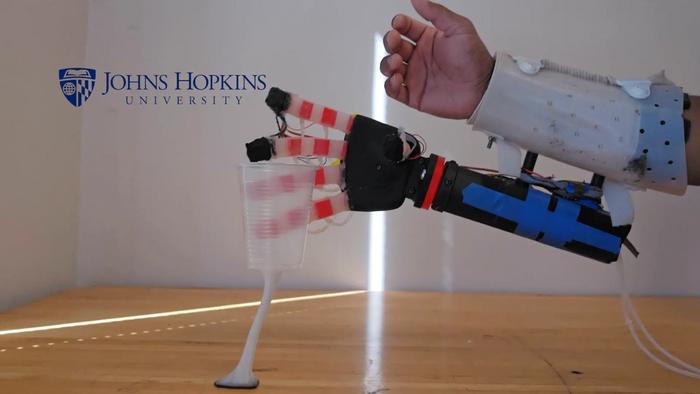Johns Hopkins University engineers have achieved a remarkable milestone in neuroscience and robotics by developing an innovative prosthetic hand capable of mimicking the dexterity and sensitivity of a natural human hand. This cutting-edge device not only grasps various everyday objects with impressive accuracy but also possesses the remarkable ability to adapt its grip depending on the texture and weight of what it holds. As a pioneering advancement in prosthetic technology, this hybrid hand is set to redefine what it means to be a user of prosthetics, offering a more natural and seamless experience for individuals with upper-limb loss.
The hybrid design of this prosthetic hand combines the strengths of both rigid and soft robotics, making it uniquely adept at navigating the complexity of real-world objects. Traditional robotic hands have often struggled to replicate the delicate touch and versatility of the human hand, which can accommodate a wide range of items from fragile glassware to dense all-metal containers. The new prosthetic hand achieves this balance by integrating a soft outer shell made from rubber-like polymers, which is complemented by a rigid internal skeleton created through advanced 3D printing techniques. This combination allows users to handle items of various shapes and materials safely and effectively.
At the heart of this breakthrough is a sophisticated system of tactile sensors inspired by the biological layers of human skin. These sensors enable the prosthetic hand to discern and react to different textures and weights, providing real-time feedback that enhances the user’s grip. Unlike conventional prosthetic devices, which may simply detect touch or grip strength, this new prosthetic hand can inform the user about the object’s characteristics, allowing them to adjust their handling accordingly. The researchers have employed machine learning algorithms to refine the communication between the device and the user’s own neural pathways, delivering a vastly improved sensory experience.
Experiments conducted in the laboratory showcased the impressive capabilities of this hybrid prosthetic hand, which successfully identified and manipulated a variety of 15 everyday objects, achieving a success rate of 99.69%. Among the items tested were delicate stuffed toys and even fragile cups filled with water, all handled with dexterity and finesse typically associated with a human touch. This significant accomplishment underscores the device’s ability to adapt its grip dynamically based on the sensitivity of the objects being handled, minimizing the risk of damage while maximizing user control.
The development journey behind this remarkable technology involved a comprehensive study of the human hand’s mechanical and sensory abilities. The researchers aimed to model the prosthetic hand closely on these natural features, driven by the desire to provide individuals with upper-limb loss the ability to interact confidently with their environment. The lead engineer, Sriramana Sankar, emphasized the importance of creating a prosthetic hand that mirrors the physical attributes and sensory feedback of the human hand, thus affording users a sense of autonomy and empowerment in their daily lives.
A crucial aspect of this technology is its ability to send sensory feedback to the user, resembling the natural signals sent by a functional nervous system. The prosthetic hand uses muscle signals from the forearm similar to conventional prostheses but enhances them by reinterpreting tactile information through artificial touch receptors. This unique system enables the hand to effectively “communicate” with the user’s neural interface, providing valuable insights about the objects being grasped, including their temperature, texture, and stability.
Looking to the future, the research team is committed to refining this cutting-edge technology. While the current iteration of the hybrid prosthetic hand has proven highly effective in laboratory settings, further developments are essential to enhance its grip strength and durability. Integrating industrial-grade materials and additional sensor capabilities are among the potential improvements that could translate into even more advanced applications in real-world scenarios.
The implications of this innovative hybrid technology extend beyond prosthetics; it sets the stage for the evolution of robotic hands across various industries. As robotics continue to advance, the demand for devices capable of manipulating fragile materials or engaging in human-like interactions will only grow. This groundbreaking hybrid model represents a step toward equipping robotic hands with the nuanced handling skills reminiscent of their biological counterparts.
Researchers from a range of institutions contributed to this pioneering work, with the support of funding from notable organizations, including the Department of Defense and the National Science Foundation. The collaboration reflects a multidisciplinary approach that combines expertise in engineering and neuroscience to redefine the future of prosthetics and robotics.
As this research progresses, it stands poised to shape the development of prosthetic limbs and robotic systems that cater to the intricate demands of everyday users. The aim is not only to provide a functional substitute but to restore a sense of human connection and tactile perception that those with upper-limb loss have sorely missed. By bridging the gap between human-like dexterity and robotic precision, this innovative prosthetic hand marks a new era in assistive technology and brings hope to countless individuals seeking to regain their autonomy.
In summary, the advancement of this biomimetic prosthetic hand serves as a testament to human innovation and the relentless pursuit of technology that uplifts those navigating the challenges of limb loss. By integrating the duality of rigidity and softness, this new prototype encapsulates the essence of what makes human hands so distinctive and showcases the potential of hybrid systems in creating adaptive, responsive solutions tailored to individual needs.
Subject of Research: Not applicable
Article Title: A natural biomimetic prosthetic hand with neuromorphic tactile sensing for precise and compliant grasping
News Publication Date: 5-Mar-2025
Web References: Science Advances
References: Not applicable
Image Credits: Sriramana Sankar/Johns Hopkins University
Keywords
Neural prosthetics, Prosthetic limbs, Tactile perception, Soft robotics, Sensory systems, Polymer engineering, Electrical engineering, Robotic grippers, Human-robot interaction.
Tags: 3D printing in prostheticsadvanced prosthetic solutionsbionic hand technologydexterity and sensitivity in prostheticsgrip adaptation technologyhybrid prosthetic designmimicking human sensationneuroscience and roboticsprosthetic hand advancementssoft and rigid roboticsupper limb prosthetics innovationuser experience in prosthetic devices





